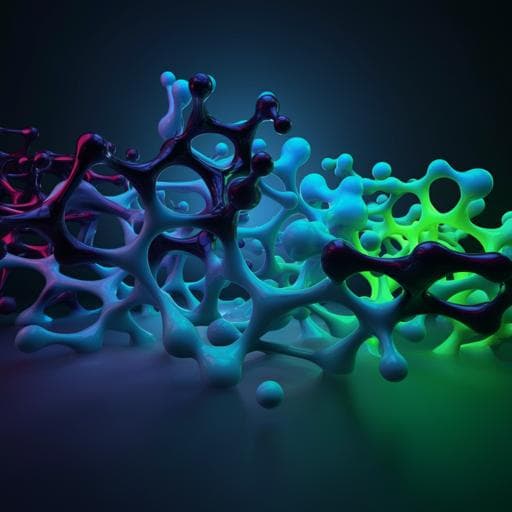
Engineering and Technology
The electrode tortuosity factor: why the conventional tortuosity factor is not well suited for quantifying transport in porous Li-ion battery electrodes and what to use instead
T. Nguyen, A. Demortière, et al.
This paper by Tuan-Tu Nguyen and colleagues presents a novel numerical approach that challenges conventional methods for determining tortuosity factors in porous Li-ion battery electrodes. By introducing a new 'electrode tortuosity factor,' the research uncovers critical insights into how non-percolating pores impact performance, paving the way for optimized electrode design. The simulation tool is also available as an open-source MATLAB application.
~3 min • Beginner • English
Introduction
The study addresses how microstructure controls transport and performance in lithium-ion battery electrodes and questions the suitability of the conventional tortuosity factor (based on steady-state through-flow) for characterizing porous electrodes. In practical electrodes, ion transport from the separator to the solid/liquid interface and electron transport from the current collector combine at the interface; therefore, pores that do not percolate across the full thickness (dead-end pores) may still contribute to operation. The paper aims to compare two adapted tortuosity determination approaches for electrodes—the restricted diffusion method (eRDM, time domain) and the symmetric cell method (eSCM, frequency domain)—and to introduce and advocate for an "electrode tortuosity factor" that better reflects relevant transport. The work emphasizes the need for accurate, representative parameters (porosity, surface area, tortuosity) for physics-based models such as Newman’s P2D, and highlights anisotropy and inhomogeneity as practical concerns.
Literature Review
The conventional tortuosity factor τ is defined via ratios of effective and intrinsic transport properties (conductivity, resistivity, diffusivity) and is equivalent to the MacMullin number. Geometric tortuosity measures exist but inadequately capture 3D pore networks and constrictions. Two experimental techniques are commonly used for porous, electronically insulating materials: restricted-diffusion method (RDM) in the time domain, and symmetric cell method (SCM) in the frequency domain, both requiring electrolyte-filled pores with known κ0 and D0. For electronically conducting electrodes, adaptations exist: eRDM (Thorat et al.) uses a free-standing electrode isolated by separators and fits time-domain relaxation using a transport model; eSCM (Landesfeind et al., Malifarge et al.) uses EIS in a symmetric cell with ion-blocking conditions to extract κeff via TLM analysis. Prior comparisons (Pouraghajan et al.) show reasonable agreement where both can be used, with eSCM often being faster and more convenient. 3D imaging (XCT, FIB-SEM) provides microstructural metrics but suffers from resolution/phase-contrast limitations, especially for carbon-binder, impacting interfacial area estimates. TauFactor provides open-source computation of tortuosity from tomographic data using steady-state diffusion (akin to eRDM). Prior work also documents anisotropy/inhomogeneity in effective properties and the occurrence of deviations from ideal TLM responses in EIS when microstructures are non-homogenizable.
Methodology
The authors develop and integrate into TauFactor a new frequency-domain solver to simulate eSCM directly on segmented 2D/3D microstructures and compare it with the existing steady-state diffusion solver (eRDM). Two core methods are analyzed:
- eRDM (time-domain): A free-standing electrode is sandwiched between separators and Li foils. A current step generates a salt concentration gradient; during relaxation, reference electrodes monitor potential decay. A transport model (Mac-Innes equation for concentrated solutions) including ionic migration/diffusion and Li/electrolyte interfacial kinetics fits the decay to extract Deff, hence τ via effective property ratios. Known separator porosity/tortuosity are used to deconvolute the electrode’s contribution.
- eSCM (frequency-domain): Symmetric cell with two identical (non-intercalating or in a non-intercalating state) electrodes separated by a separator; ion-blocking boundary condition prevents faradaic processes. EIS is measured; mid-frequency 45° slope originates from distributed double-layer capacitance interacting with ionic migration in pores. Analysis uses a transmission line model (TLM) where the electrode’s solid-phase electronic resistance is assumed negligible (Rel ≪ Rion). The porous electrode impedance reduces to a finite-space Warburg-like form: Zb = Rion · sqrt(Zt/Rion) · coth( sqrt(jω · Acc · Cdl · Rion) ), with Zt becoming a pure Cdl (per unit microstructural active surface area) under blocking conditions. From low/high-frequency limits, Rion is obtained; τe follows from τe = Rion · Acc · κ0 / NMe. Deviations from the ideal 45° slope indicate non-uniform accessible surface area per depth or non-representative control volumes.
Numerical implementation:
- TauFactor solves the steady-state diffusion equation for eRDM and a new frequency-domain set for eSCM on segmented images. For eSCM, the geometry comprises two identical porous electrodes with a separator domain; potentials Φ1 (solid) and Φ2 (liquid) with interfacial capacitive current density jw Cdl (Φ1−Φ2) and ionic migration −Keff ∇Φ1; sinusoidal boundary conditions are applied and Fourier-transformed to constant-amplitude boundary conditions per frequency. The solver is pre-compiled in C++ and uses over-relaxation.
- Fitting: The simulated symmetric-cell impedance is normalized and nonlinearly fitted to the analytical TLM expression via least-squares (MATLAB fminsearch) to extract Rion and Cdl-derived parameters; τe can also be estimated from ω→0 and ω→∞ limits.
Microstructures and parameters:
- 2D synthetic microstructures (MS Paint) to illustrate through-pores vs dead-end pores and morphological effects; pore classification based on steady-state flux thresholding (e.g., 2% of maximum) into through vs dead-end.
- 3D synthetic microstructures generated by random packing of spheres (GeoDict GrainGeo) to mimic electrodes; cases include varying particle size and porosity and a graded-porosity example (90% thickness at ε=0.35 with a 10% layer at ε=0.20 adjacent to separator or current collector).
- Example parameter set for eSCM: κ0 = 0.04615 m−1 (10 mM TBAPClO4 blocking electrolyte), Cdl = 0.012 F m−2 (per unit microstructural active surface area), frequency range 1e7–1e10 Hz, voxel size 1 µm (unless otherwise stated). In some 3D simulations a free electrolyte layer is used between electrodes (no porous separator) for simplicity.
- Outputs: τ from eRDM, τe from eSCM; MacMullin numbers NM and NMe; pore network percolation fractions (through vs dead-end) and flux density maps; analysis of EIS shapes versus ideal TLM response.
Key Findings
- Conceptual distinction: The conventional tortuosity τ (eRDM) measures steady-state through-flow and ignores the role of dead-end pores, whereas electrodes operate via access to interfacial area; dead-end pores can materially contribute. A new electrode tortuosity factor τe (eSCM) better captures access to surface area.
- Simple 2D cases: For straight through-pores, τ = τe = 1 as expected. For a geometry comprising only a straight dead-end pore, eRDM yields τ = ∞ (no through transport), while eSCM yields τe < 1, indicating interfacial area is very easy to access relative to straight through-pores.
- 2D networks with identical NM but different dead-end morphologies: Adding ~6% dead-end pore volume (branched from the main through-pore) does not change NM by eRDM across variants and gives identical τ among B/C/D in eRDM, despite very different pore morphologies. In contrast, τe increases in accordance with how hard it is to access the added surface area: many short branches (higher A′) increase area with modest increase in τe; bulky short branches farther from the separator give higher τe with modest area gain; few long branches give the largest τe due to difficult access. The mid-frequency EIS deviates from the ideal 45° slope when accessible surface per penetration depth varies.
- 3D realistic microstructures (random packed spheres):
• Case A (ε≈0.35, smaller particles): Through-pores ≈96%, dead-end ≈4%; eSCM τe ≈ 2.58–2.60 with NMe ≈ 7.37–7.43; eRDM τ in close agreement. EIS close to ideal TLM.
• Case B (ε≈0.20, larger particles): Through-pores ≈92%, dead-end ≈8%; eSCM τe ≈ 3.35–3.48 with NMe ≈ 14.56–15.13; eRDM τ in close agreement. EIS shows deviations from ideal TLM due to variations in accessible surface area per depth, indicating limited representativeness or intrinsic non-homogenisability.
- Graded-porosity 3D microstructure (90% thickness at ε=0.35; 10% layer at ε=0.20): Dead-end pores ≈33% with many long dead-ends. Orientation strongly affects τe:
• Dense layer at current collector: τe ≈ 4.0, NMe ≈ 11.8, despite conventional τ ≈ 7.4 (eRDM), and EIS near ideal TLM.
• Dense layer at separator: τe ≈ 11.9, NMe ≈ 35.1, exceeding τ by eRDM; EIS deviates from ideal due to strong depth-variation in accessible surface area.
- Representative 2D demonstration (Fig. 2): Case A (ε=34.7%) τ≈2.25 with NMc≈6.49; Case B (ε=22.6%) τ≈1.47; removing dead-end pores leaves NM unchanged for through-transport in eRDM, underscoring that dead-ends minimally affect steady-state through flux but significantly affect access to surface area.
- Diagnostic from EIS shape: Deviation from 45° mid-frequency slope signals non-uniform accessible surface per depth or insufficiently large control volume. The eSCM simulation can quantify departures from porous electrode theory.
- Practical modeling implication: τe should replace τ in P2D/TLM parametrization for porous electrodes; τe can be <1, and is directionally dependent for graded structures, reflecting real performance trends (e.g., dense binder layer near separator harms rate capability).
Discussion
The findings show that conventional tortuosity τ, derived from steady-state through-flow (eRDM), does not appropriately quantify transport relevant to electrode operation because it excludes contributions from dead-end pores that still provide electrochemical surface. The electrode tortuosity factor τe (eSCM) measures the difficulty of accessing interfacial area and aligns with the physics of ion migration and double-layer charging under blocking conditions. Across synthetic 2D and 3D cases, τe differentiates microstructures with identical τ or NM by capturing how morphology (branch length, location, and distribution of surface area) affects accessibility. In realistic 3D packed-sphere electrodes with few dead-ends, τ and τe agree, explaining why some experimental methods concur for typical commercial electrodes. However, with increased dead-ends or graded porosity, τe departs strongly from τ and is directionally sensitive, mirroring observed performance asymmetries when dense layers are near the separator. The EIS signature (departure from the ideal 45° slope) serves as a diagnostic for representativity and homogeneity assumptions behind porous electrode theory. Consequently, replacing τ with τe in P2D/TLM models yields a microstructural descriptor that encodes accessibility of surface area, improving predictive fidelity for power performance and design optimization (e.g., graded porosity with higher ε near the separator).
Conclusion
The study introduces the electrode tortuosity factor τe and a frequency-domain eSCM solver integrated into TauFactor, enabling direct computation of symmetric-cell impedance and τe from segmented microstructures. It demonstrates conceptual flaws in using conventional τ from eRDM to characterize electrodes, especially in the presence of dead-end pores and graded/anisotropic structures. τe better reflects transport relevant to electrode operation and can even be less than unity, indicating superior accessibility. In typical 3D microstructures with high percolation, τ and τe may agree; however, for microstructures with significant dead-end fractions or strong depth-dependent morphology, τe diverges and provides actionable insight (e.g., orientation effects and optimal graded designs with higher porosity near the separator). The work recommends adopting τe in P2D/TLM models and using deviations in symmetric-cell EIS from ideal TLM as a quantitative check of homogenisability. Future work will apply these concepts to real electrode tomographic data to guide optimal electrode design.
Limitations
- eSCM analysis assumes negligible electronic resistance of the solid matrix relative to ionic resistance; deviations require generalized TLM including Rel, contact resistances, or charge-transfer elements.
- Blocking conditions are assumed (no faradaic processes), and electrolyte concentration gradients are neglected; applicability requires sufficiently high electrolyte concentration and moderate interfacial area to avoid significant ion depletion.
- Separator contribution is treated as a simple series resistance at high frequency; in some simulations a free electrolyte layer (no porous separator) is used for simplicity.
- Synthetic microstructures may not capture all complexities of real electrodes; tomographic limitations (resolution, phase contrast, especially for carbon-binder domain) can bias surface area and morphology metrics.
- Control volume representativity is critical; small volumes relative to structural length scales lead to non-ideal EIS and may not reflect bulk behavior.
- Dead-end pore identification uses an arbitrary flux-density threshold (e.g., 2% of maximum), potentially affecting classification.
- eRDM extraction requires accurate electrolyte properties and separator parameters; decorrelation from separator layers introduces uncertainty.
Related Publications
Explore these studies to deepen your understanding of the subject.







